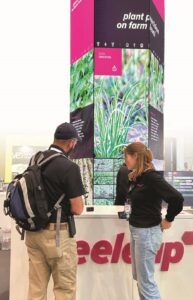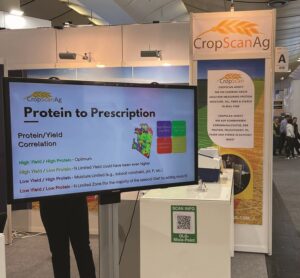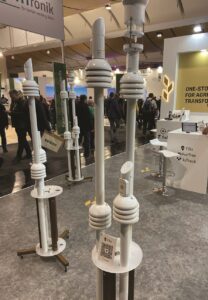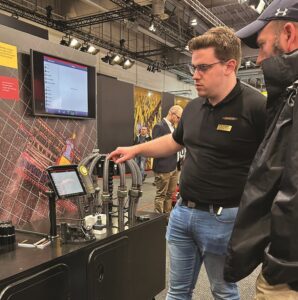Five highlights from AgriTechnica
I walked at least 10 km and 20,000 steps every day of AgriTechnica, seeing new tools and talking farm machinery with people from all over the globe. The “world’s leading trade fair for agricultural machinery” attracted 2,813 exhibitors and 473,687 visitors for a week in November in Hanover, Germany. Here is just a sample of tools that caught my eye.

CropScan Ag scans grain to create quality map
I talked to the folks at the CropScan Ag booth about their near infrared analyzer and mapping system that maps moisture, protein, oil, starch and fibre of grain while being harvested. Rocky Mountain Equipment, Vantage Canada and Webbs Machinery currently offer this technology in Canada as an add-on system to pretty much any combine brand or type.
CropScan Ag representatives from Australia were very familiar with Western Canadian farmers and cropping systems as Canadian farmers have used the technology for a number of years now. Farmers can use the maps from multiple seasons of data to fine tune nitrogen fertilizer application and improve fertilizer efficiency and profitability. The representatives showed me how, in a canola-wheat rotation, their variable-rate fertilizer system could improve yields and reduce grain quality variability. The Olds College Smart Farm is evaluating this technology as well. cropscanag.com

BeeLeap adds optical spraying as a retrofit
Sprayer controls and spot spraying technology were a common theme at AgriTechnica 2023 with many different companies in this space. I talked to representatives from BeeLeap and got some insight into how this technology is evolving and what farmers should be looking at when considering adoption of these systems. BeeLeap offers an integrated system of sprayer controls, cameras and cloud solutions to do a better job of spraying.
The ability to control spray application from broad-acre applications to plant specific applications is the goal for growers who want to spray only the right amount of product and only where it is needed. Government regulations in Europe are driving the adoption of this tech, but farmers in Western Canada are likely to see agronomic return on investment through improved product performance and reduced product applied.
BeeLeap offers the cameras, rate controllers and artificial intelligence (AI) deep earning algorithms as retrofits compatible with any ISO-BUS equipped sprayer. Real-time detection and spraying combined with the ability to use historical map layers and record application information is how farmers can use this technology to help improve their bottom line. beeleap.com
Sensor-based agronomy advice from Doktar

Ag-tech company Doktar leverages sensor technology to provide agronomic advice. I was particularly curious about their SoilScanner, which provides digital soil analysis, PestTrap, a digital pest tracking station, and Filiz, a soil and moisture sensor station.
My neighbours and I have been using the SoilScanner, available through ATP Nutrition in Western Canada, on our farms since April 2023. I was curious about any insights the Doktar representatives had about this tool. Their experience was very similar to mine, with the sensor providing instant analysis of soil nutrients and fertility recommendations right in the field.
PestTrap uses machine learning to identify and count pests in real-time. PestTrap has sticky paper and an integrated camera accessed through the “internet of things” IoTrack mobile app. It captures daily imagery and accurately identifies pest types. It will also send notifications when pest levels reach a risk threshold. Farmers and agronomists in Western Canada will be very interested to see how this technology adapts to canola pests to help with field scouting.
Filiz agricultural sensor station monitors soil and weather conditions in the field to help forecast disease risk status, irrigation scheduling and crop phenology stages. It also connects to the IoTrack mobile app to review data and receive notifications from the device in the field.
Sensor technology in the field won’t replace good crop scouting, but I think canola growers in Western Canada who adopt sensor technology to improve scouting and increase efficiency in the field will realize the benefits offered by these products. doktar.com/en
Väderstad SeedEye automatically hits target seed rate
After walking through the Kanada booth in Hall 12, I spent some time talking with a Väderstad representative who gave me a demonstration of the SeedEye sensor technology. The operator sets a target number of seeds per square foot, and SeedEye automatically adjusts seed rate to hit that target. The farmer doesn’t have to make any calculations based on seed weight, seed lot, seed bag weight or seed size. With SeedEye, the farmer gets the exact number of seeds in the field. The technology is available on Väderstad seed drill models Spirit 600-900S and Rapid A 600-800C/J.
Canola growers know how critical it is to establish a uniform plant stand of five to eight plant per square foot. With technology like SeedEye adapted to air-seeder systems, growers will have more confidence in their ability to achieve that target stand and start the growing season correctly. vaderstad.com/ca-en

Proofminder analyzes field imagery for crop stage, weeds and more
At the Start-Up Stage at AgriTechnica, I saw an interesting presentation titled “How can we use AI to help agronomists obtain leaf-level information from large fields and improve profitability?” The presenter from Proofminder discussed AI tools available right now to help agronomists with in-field evaluation of crop ripeness and maturity, weed detection, variable rate spot spraying and statistical analysis of the crop. The Proofminder model uses aerial drone imagery with RGB cameras to evaluate and generate maps that provide these insights.
Improvements in high resolution image analysis, machine learning and data analytics will bring these tools closer to farmers and agronomists in Western Canada and help them scout more acres more efficiently with accuracy and reliability. proofminder.com




